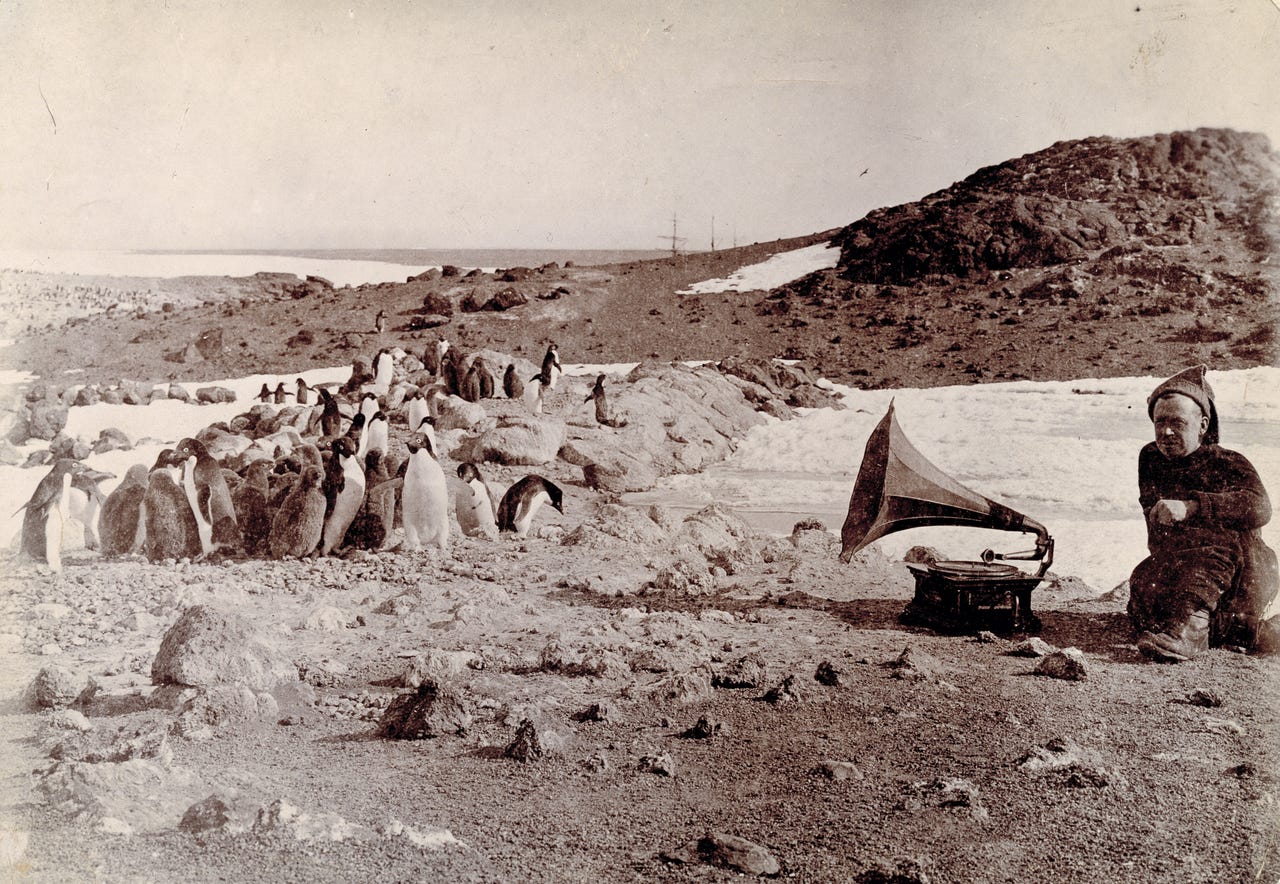
































Penguins enjoying "Waltz me around again Willie" in Antarctica in 1907 during the British Antarctic Expedition.
Step into my office and you'll immediately see it's an amalgam of old and new school technology. As for the old-school, I have racks of vinyl and a turntable that proves I much prefer the warmth of analog. And because I work from home, I can listen to vinyl all day.
Also: This Linux distribution is an audio content creator's paradise
That doesn't mean I limit myself to strictly vinyl. I have a sizable collection of CDs that includes recordings that are unavailable either on vinyl or streaming services. As I've mentioned before, it is possible to add your local files to Spotify, which I do. But when I want to dig deeper into the track and experience the music exactly how I'd like, I often will turn to an old-school music player, such as Qmmp. Qmmp is a Linux clone of the old Winamp app (which has made a surprising resurgence on Android, iOS, and Windows).
Or, I might turn to the music player that was my default for years -- Clementine. I've always considered Clementine to be a sort ofbest-of-all-worldsmusic app because it includes all the features I need (playlists, libraries, files, equalizer, queue manager, CD ripping) and even additional features I may or may not use (internet radio and device connection).
With Clementine, you get an incredible music manager tool, a powerful EQ, and more.
Both Clementine and Qmmp include 10-band EQs, which allow me to fine-tune the music to my exact specifications. Although both apps allow you to save custom EQs, only Clementine includes a collection of pre-configured EQ settings (such as Classical, Club, Dance, Dubstep, Large Hall, Live Hall, Rock, etc.). I'm always surprised at how accurate the Clementine EQ presets are. Also, both apps offer pre-amp sliders so you can bump the volume of your favorite tracks until you can feel the beat to your core.
I love the old-school look of Qmmp.
Ultimately, however, my primary reason for opening one of these apps is because of the music I've collected over the decades that simply isn't available anywhere else. For example, way back around the time of Y2K, I attended a Linux convention and picked up a free copy of a CD called "The Sounds of Slashdot," created by Sam Mehat. Any time I need to enjoy some trance music, that's the album I want. I still have the CD and, long ago, burned it to digital format. The only way I can listen to that album is either by adding it to Spotify or opening one of my old-school music players.
Also: The best sound systems: Expert recommended
Guess which app I turn to? That's right -- either Clementine or Qmmp. With those two apps, I can not only hear the music exactly how I want, but I can also watch the visual analyzer display the beat to remind me that I am still a child of a period when an impressive stereo rack made you feel like you were the ruler of the universe.
Between the two, I would say that Qmmp offers the best classic feel (and a killer visualizer) but Clementine's EQ is hard to beat for switching between presets or customized settings. Also, Clementine's queue management and playlist feature is amazingly simple.
But how do you install these two music players?
It's very simple.
What you'll need: To install either one of these music players, you'll need a running instance of your favorite Linux distribution and a user withsudoprivileges.
First, we'll install Qmmp, which I would recommend doing with Flatpak. Any distribution that includes Flatpak has access to the Qmmp package via Flathub, so the installation is as simple as:
flatpak install qmmp
Make sure to answeryto the questions. (Although if you're using Fedora, you'll need to select a repository, which is done by typing the number associated with the repo you want to use.) After the installation, log out and log back in so the Qmmp launcher is added to your desktop menu.
Also: The best Linux distros for beginners
If you're using a Debian or Ubuntu-based distribution, the installation command for Clementine is:
sudo apt-get install clementine -y
If you're using a Fedora-based distribution, the installation command is:
sudo dnf install clementine -y
Also: Finally! This is the Linux email client I've been hoping for
Once you have either player installed, you can open it, add music to your library/playlist, and start listening. If you're a lover of music, you'll appreciate the ability to play those out-of-publication tracks with an old-school twist that only these types of apps can bring. Unless you have a turntable, which should always be your first choice when you want to hear music recordings as they were intended.
 Tags quentes :
Home & Escritório
Entretenimento em casa
Tags quentes :
Home & Escritório
Entretenimento em casa